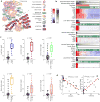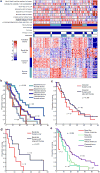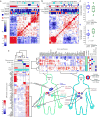Virtual microdissection identifies distinct tumor- and stroma-specific subtypes of pancreatic ductal adenocarcinoma
- PMID: 26343385
- PMCID: PMC4912058
- DOI: 10.1038/ng.3398
Virtual microdissection identifies distinct tumor- and stroma-specific subtypes of pancreatic ductal adenocarcinoma
Abstract
Pancreatic ductal adenocarcinoma (PDAC) remains a lethal disease with a 5-year survival rate of 4%. A key hallmark of PDAC is extensive stromal involvement, which makes capturing precise tumor-specific molecular information difficult. Here we have overcome this problem by applying blind source separation to a diverse collection of PDAC gene expression microarray data, including data from primary tumor, metastatic and normal samples. By digitally separating tumor, stromal and normal gene expression, we have identified and validated two tumor subtypes, including a 'basal-like' subtype that has worse outcome and is molecularly similar to basal tumors in bladder and breast cancers. Furthermore, we define 'normal' and 'activated' stromal subtypes, which are independently prognostic. Our results provide new insights into the molecular composition of PDAC, which may be used to tailor therapies or provide decision support in a clinical setting where the choice and timing of therapies are critical.
Figures






Comment in
-
Gene signatures from pancreatic cancer tumor and stromal cells predict disease outcome.Nat Genet. 2015 Oct;47(10):1102-3. doi: 10.1038/ng.3408. Nat Genet. 2015. PMID: 26417858
-
Subtyping Pancreatic Cancer.Cancer Cell. 2015 Oct 12;28(4):411-413. doi: 10.1016/j.ccell.2015.09.020. Cancer Cell. 2015. PMID: 26461089
-
Pancreatic cancer: Classifying pancreatic cancer using gene expression profiling.Nat Rev Gastroenterol Hepatol. 2015 Nov;12(11):613-4. doi: 10.1038/nrgastro.2015.180. Epub 2015 Oct 20. Nat Rev Gastroenterol Hepatol. 2015. PMID: 26484444 Free PMC article.
References
Publication types
MeSH terms
Associated data
- Actions
Grants and funding
LinkOut - more resources
Full Text Sources
Other Literature Sources
Medical
Molecular Biology Databases

